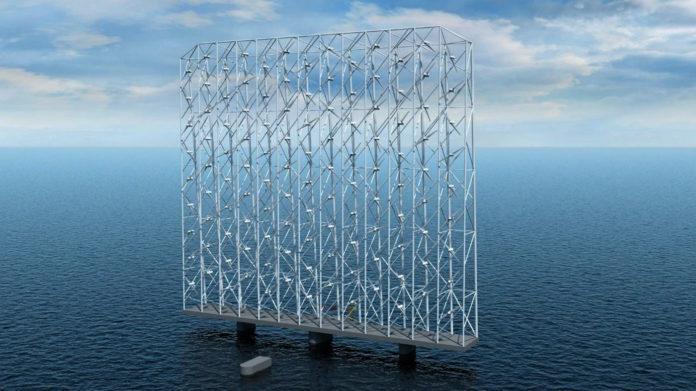New Wind Energy Concept Analyzed

Keep in mind that the power generated by a wind turbine is a function of its “swept area,” meaning the area of the circle made by the tip of the blades.
Let’s say this array is in the shape of a square with sides of n.
A single blade rotating inside that square would have a radius n/2, and its area would be π(n/2)2 or πn2/22 or πn2/4.
Now, let’s look at these guys’ array. Suppose there are 10 x 10 = 100 smaller turbines. Each blade has a radius of n/20, so the total is 100 π(n/20)2 or 100 π(n2/202) or πn2/4.
These guys’ solution has the identical swept area to that of the conventional solution. The only differences are in the enormous amount of materials that go into the new one, and the incredible maintenance associated with 100 tiny turbines.
Here are the company’s claims, with my comments in italics.
While bottom-fixed offshore wind turbines are being built in large parts of the world, floating offshore wind turbines are seen as more demanding. True.
Norway’s Wind Catching Systems (WCS), in collaboration with Aibel and the Department of Energy Technology, has announced plans to commercialize its groundbreaking Wind Catching technology that they hope will be able to compete with bottom-mounted turbines and other floating concepts. Per the analysis above, it won’t.
Windcatcher floating offshore wind turbine array can generate five times the annual energy production of the world’s biggest single turbines while reducing the operating costs. Windcatcher grids stand more than 1000 ft high, deploying multiple smaller turbines in a staggered formation atop a floating platform moored to the ocean floor. Well, obviously, if you say this thing is going to be 1000 feet high, 80% the height of the Empire State Building, you can say all kinds of garbage. Why not make it a mile high? That wouldn’t be much more outrageous.
The offshore wind turbine array has double the swept area of a conventional 15 MW wind turbine, and its smaller rotors could perform much better in wind speeds over 11-12 m/s (40 to 43 km/h). The solution aims to cuts land use by more than 80% and increases efficiency, compared to conventional floating offshore wind farms. How will it cut land use, if it’s the same size?
According to the company, one Wind Catching unit produces enough electricity for 80,000 European households. Five Wind Catching units can produce the same amount of electricity as 25 conventional turbines. These arrays will have a lifespan of 50 years and will be significantly more cost-effective than current alternatives. At the same time, the technology will solve sustainability problems related to the reuse of turbine blades, fishery resources, and CO2 emissions from installation and maintenance. This solution uses far more material than the conventional approach, and anyone with any sense can see that this is going to be a maintenance nightmare.
The goal is to carry out the technical verification during 2021. Just ask a high school math-physics kid who gets good grades. …. and to offer commercial development solutions in 2022. Nope.
